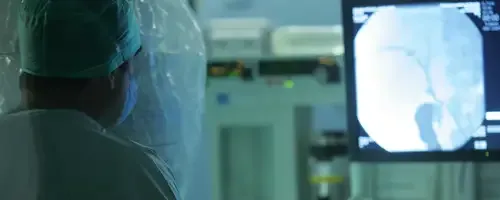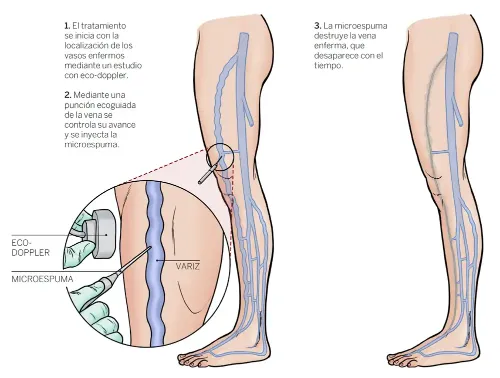Venous and lymphatic insufficiency
"Microfoam phlebosclerosis is a very effective technique for varicose veins of the lower extremities."
DR. EUGENIA PILLADO
SPECIALIST. VASCULAR SURGERY SERVICE
Chronic venous insufficiency is the clinical picture caused by the difficulty of venous return from the lower extremities.
The World Health Organization defines varicose veins as "dilations of the veins that are often tortuous.
The whole process leading to chronic venous insufficiency is favored by orthostatism so that anyone can suffer from the disease.
However, it is more common in women and has a higher incidence in obese people and people whose professional activity requires prolonged periods of standing.
The Clinica Universidad de Navarra offers patients with varicose veins a high-resolution consultation: in a single session, the doctor performs tests to determine the type of varicose vein and its severity, and offers a diagnosis and a personalized treatment plan according to the size, location or morphology, and the severity.

What are the symptoms of venous insufficiency?
The clinical picture is varied and includes from the asymptomatic patient, whose only concern is the aesthetic problem that involves the existence of varicose veins, the patient with the characteristic symptoms (heavy legs, pain, cramps and feeling of permanent fatigue, which improves with rest, elevation of the limb and cold and worsens with standing and heat).
In more advanced stages, skin color changes and even stasis ulcers may occur.

Learn what varicose veins are and how they are treated (available in spanish)
The most common symptoms are:
- Heavy legs.
- Pain.
- Cramps.
Do you have any of these symptoms?
You may have a varicose vein problem
What are the causes of varicose veins?
The blood circulation ensures, thanks to the arteries, the supply of oxygen to the various organs and tissues, and, thanks to the veins, the return to the heart of the blood poor in oxygen.
To perform this return function, different mechanisms allow us to overcome the force of gravity. When any of these mechanisms fails, the blood stagnates in the veins, their walls dilate and their structure and function are altered, and the symptoms appear.
Who can suffer from varicose veins?
It will depend on each case but, as already stated, there is no definitive treatment to cure chronic venous insufficiency so, regardless of the treatment applied, the use of elastic support and observation of the general measures mentioned are the basis of success in controlling the disease and the only way to combat the emergence of new varicose veins after treatment.
How is venous and lymphatic insufficiency diagnosed?

The physical examination is usually sufficient to establish the diagnosis of varicose veins (venous and lymphatic insufficiency) although there are some data that must be known.
For this reason, there are complementary tests, including the eco-doppler-color that provides more information.
In some cases it is necessary to perform a phlebography with contrast.
How are varicose veins treated?
Currently, there is no definitive treatment that allows for the total recovery of the damage produced in the venous system. However, prevention and evolutionary control of chronic venous insufficiency and its complications can be achieved.
The use of compression stockings is perhaps the most important part of the treatment since, in a way, they exercise the return function that sick veins cannot perform.
There is a wide variety of venotonic drugs on the market that improve the functioning of the venous system and effectively relieve symptoms.
Surgery for varicose veins has been accepted for years as the most effective therapeutic method with the best prognosis, although it is not always indicated and may not be sufficient.
Starting in the 1990s, and in view of the good clinical results, there began to be a growing interest in the treatment of varicose veins by means of sclerosing agents in the form of foam, in whose application the Clínica Universidad de Navarra is a pioneer.

In November 2001, the Clínica Universidad de Navarra incorporated a pioneering technique for the treatment of varicose veins. This is phleboesclerosis with microfoam, which allows the varicose vein problem to be treated without the need to go through the operating room or interrupt normal life.
This technique is an outpatient procedure that lasts 45 minutes, with hardly any discomfort and does not require anesthesia.
It consists of injecting into the affected vein a substance (polidocanol) treated to turn it into a microfoam. It causes hardly any discomfort to the patient and in a few treatment sessions excellent results are achieved.
The substance injected into the vein displaces the blood and adheres to the internal wall of the vein, thus destroying the internal tissue. With very little quantity and very low concentration of the active ingredient, an effective volume of microfoam is achieved to treat large caliber veins. This has allowed its application in the treatment of all types of varicose veins, including truncal varicose veins.
It is a technique that offers high security as the doctor has a permanent control of the path of the foam and the dose used throughout the process.
The results are seen within days and after a few months the vein is reduced to a scar where no blood circulates.

It is a treatment that is performed through a single puncture under local anesthesia, without the need for incisions or sutures. The specialist, through a catheter, accesses the varicose vein through the skin (which does not suffer any damage) and injects the medical adhesive in a single procedure.
The duration is one hour and does not require surgical intervention, since it is performed on an outpatient basis.
Therefore, recovery is immediate and, furthermore, after the puncture, it is not necessary to wear elastic compression stockings.

It is a minimally invasive intervention that is performed in the operating room, allowing the patient to return to his/her daily activities two hours after treatment. To eliminate varicose veins, the specialist uses heat emitted by a laser fiber or a radiofrequency fiber.
After the operation, it is necessary to use a compression stocking for a few days, depending on the type of varicose vein.
- Practice a suitable sport (walking, swimming).
- Avoid overweight.
- Avoid heat sources.
- Refresh your legs with cold water baths.
- Avoid constipation.
- Avoid wearing clothes that are too tight.
- Use shoes with a 3-4 cm heel; avoid high heels and flat shoes.
- Slightly elevate the feet from the bed.
- Massage your legs.
- Avoid taking oral contraceptives.
Where do we treat it?
IN NAVARRE AND MADRID
The Vascular Surgery Service
of the Clínica Universidad de Navarra
The Vascular Surgery Service of the Clinic has the latest technology for the diagnosis, treatment and surgery of vascular pathologies. Our wide experience, framed in the quality care environment of the University of Navarra Clinic, allows us to offer the patient the most effective and innovative treatments.
We have an operating room specialized in vascular surgery, equipped with advanced equipment for the surgical treatment of the most important vascular diseases.
We are pioneers in endovascular brachytherapy, localized radiotherapy to treat tumors, which has been practiced in the world on very few occasions.
Diseases we treat
- Diseases of the aorta
- Carotid diseases
- Chronic venous insufficiency (varicose veins)
- Ischemia of lower extremities
- Varicose ulcers

Why at the Clinica?
- En menos de 24 horas podemos realizar las pruebas necesarias para establecer el diagnóstico y el planteamiento del tratamiento.
- Área de Flebología pionera en España en el tratamiento de varices con microespuma.




